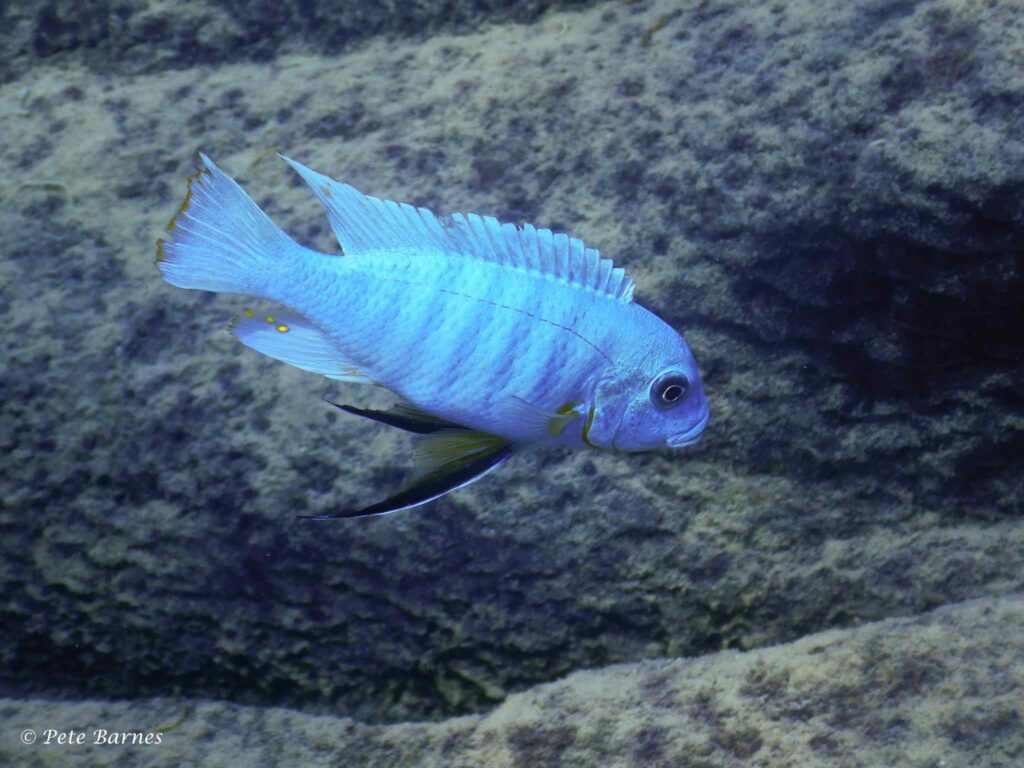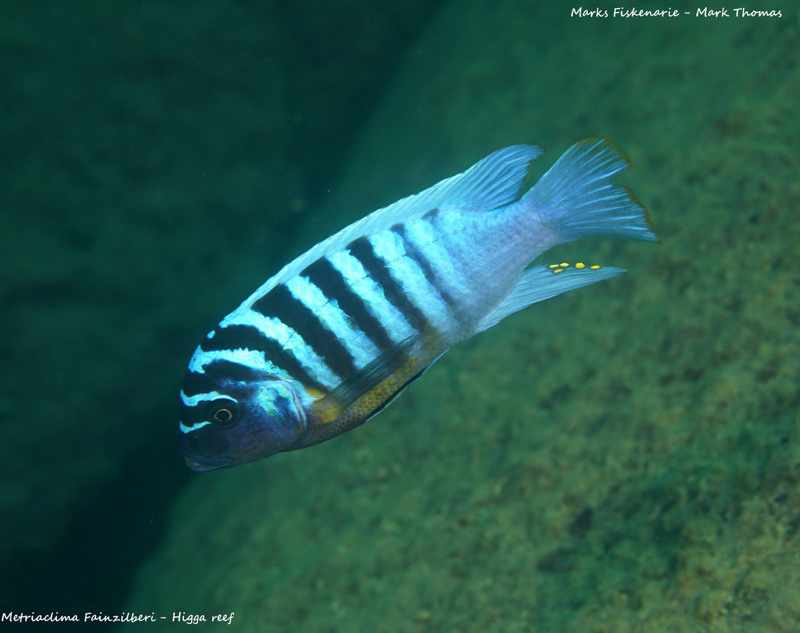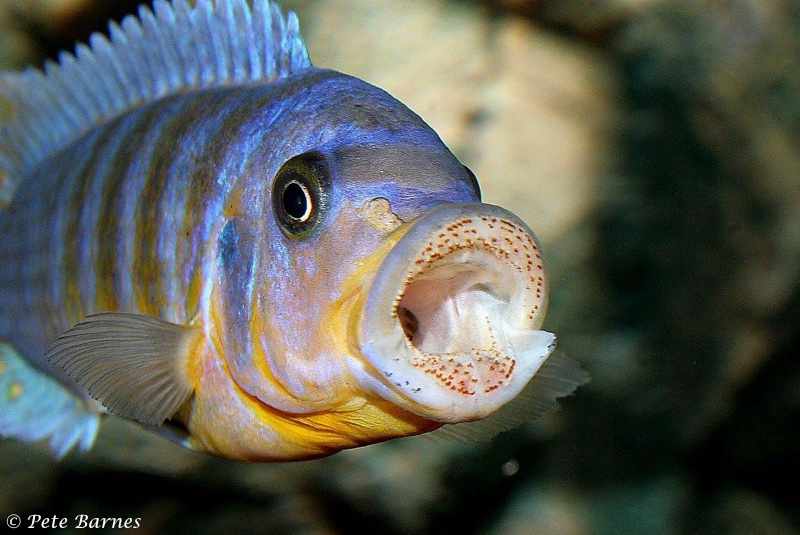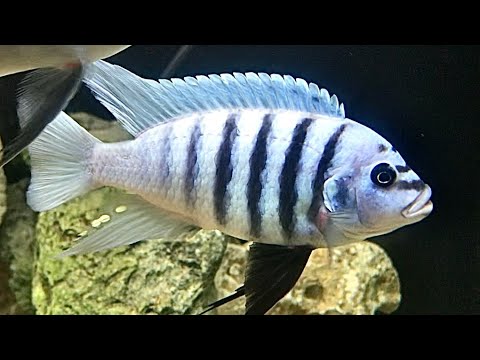Maylandia fainzilberi
Maylandia fainzilberi is a fascinating freshwater fish known for its striking colors and interesting behavior. This species belongs to the family of cichlids, a group of fish commonly found in aquaristics.
Scientific name and description
The scientific name of this species is Maylandia fainzilberi. The species was first described by Staeck in 1976.
However, there is a taxonomic debate about the validity of the genus name. Many authors recognize Metriaclima Stauffer, Bowers, Kellogg & McKaye 1997 as the valid name, arguing that Maylandia lacks a diagnosis and is therefore unavailable. However, Eschmeyer’s Catalog of Fishes treats the older name Maylandia as valid. The name Metriaclima fainzilberi was first described by Stauffer, Bowers, Kellogg & McKaye in 1997.
Family
Maylandia fainzilberi belongs to the family of Cichlids (scientific name: Cichlidae). This family is known for the great diversity of species and their complex behavior, especially with regard to brood care.
Meaning of genus name and species name
- Genus name Maylandia: This name is a tribute to Hans Joachim Mayland (ca. 1928-2004), a well-known cichlid enthusiast and author of aquarium fish books.
- Geslachtsnaam Metriaclima: Deze naam, geïntroduceerd in 1997, is samengesteld uit twee Griekse woorden:
- Metrios means “moderate” or “average.”
- Klima means “slope”. The name refers to the “moderately sloping head” of the fish within this genus.
- Species name fainzilberi: This name was given in honor of Misha Fainzilber, an exporter of tropical fish who provided Staeck with access to Lake Malawi, where the species originated.

Description
Maylandia fainzilberi is a striking cichlid from Lake Malawi. This fish has a typical physique for a Mbuna and shows distinct differences in appearance between the sexes.
Appearance
Maylandia fainzilberi has an elongated and slightly flattened body. The basic color of the head and flanks of the “normal form” is bright blue, while the breast and belly vary from brownish-yellowish to whitish or even bright blue. About seven dark, vertical bands are visible on the flanks of adult males. These bands are less prominent on the back of the body than on the front. The head is characterized by three broad, dark transverse bands, the middle one running between the eyes and connecting them. The dorsal fin is slightly yellowish in some locations on the back, a hue that is also sometimes reflected in the caudal fin. The blue anal fin of males shows several bright yellow, black-bordered egg spots, which play an important role in reproduction. The fish has a large, slightly upper mouth with thick, fleshy lips that prevent it from closing its mouth completely. The throat teeth are very small and closely spaced.
Differences between males and females
There are distinct differences between males and females of the Maylandia fainzilberi. Males typically grow larger, reaching a maximum length of about 12-13 centimeters, while females reach a maximum length of about 10 centimeters. Males are considerably more colorful than females and juvenile fish. They develop the distinctive bright blue base color with the dark vertical bands on the flanks and transverse bands on the head. The name “golden breast” refers specifically to the distinctive golden coloration seen on the breast of males from some locations. Females and juveniles are much less conspicuous; their base color is grayish-blue and the vertical bands are only dimly visible. As young males mature, they gradually develop their distinctive bright colors and patterns.
Behavior and temperament
Maylandia fainzilberi belongs to the Mbuna cichlids, a group known for their territorial behavior. Males can be aggressive, especially toward conspecifics or other fish similar in appearance. They live in colonies and organize themselves around an established hierarchy. These fish are herbivorous by nature and live on the bottom, where they tend to dig in the sand and change their environment. They do not tolerate intruders in their habitat and can provoke intense fights, especially between dominant males, which can lead to subjugation or even death of one of the fish. They are diurnal and keep themselves between rocks and stones.
Life expectancy
The maximum life expectancy of the Maylandia fainzilberi is currently not precisely known. However, other sources suggest a life span of about 8 years in a suitable environment.
Differences in coloring by location
Although Maylandia fainzilberi occurs in different parts of Lake Malawi, especially in the northeastern part in Malawi, Mozambique and Tanzania, available sources mainly describe the “normal form” of the species. It is mentioned, however, that coloration can vary greatly (polymorphism). It is known that many Mbuna cichlids, depending on their specific geographic location within the lake, can develop local color variations or “morphes. Between the text I have posted photos of different local color variations of the males. The females from different locations are much more similar.

Biotope
Maylandia fainzilberi is a freshwater fish found exclusively in Lake Malawi, one of the largest and deepest lakes in Africa. This lake is known for its enormous biodiversity, especially in terms of cichlids. They are endemic to Lake Malawi, which borders the countries of Malawi, Mozambique and Tanzania. Several populations of the species can be found within this vast lake.
This cichlid mainly inhabits the rocky biotopes of Lake Malawi, at depths of less than 5 meters. This means they live in areas with many rocks and rock formations, which serve as hiding places and territories. The rocks are often covered with a “biomat” or biofilm of algae called aufwuchs, which is an important food source for these fish. The presence of many caves and crevices is important for their survival, as these places provide protection from predators and serve as breeding grounds.
Natural enemies or role as hunter
Maylandia fainzilberi is a herbivore that feeds on algae, which it scrapes or brushes off the biomat on the rocks. In addition, the fish sometimes eats plankton, indicating a partially carnivorous diet. Although specific natural enemies are not mentioned in the documents, Mbunas, like the Maylandia fainzilberi, are prey for larger predatory fish in Lake Malawi.
Climate
Lake Malawi is located in a tropical zone. The lake’s water level is relatively stable compared to smaller rivers or lakes. The water temperature in Lake Malawi is warm and stable throughout the year, so there are few changes in the lake’s water values throughout the year.

Diet
The diet of Maylandia fainzilberi focuses primarily on the natural food sources available in its rocky habitat in Lake Malawi.
Food in the wild
In its natural habitat, the Maylandia fainzilberi feeds mainly on algal growths (also called ‘aufwuchs’) and the small organisms that live in them. This means that the fish is a so-called “limnivore,” meaning it scrapes or brushes algae and the microorganisms it contains off the rocks. This layer of algae, often referred to as ‘biomat’ or biofilm, is a rich food source in Lake Malawi and forms the basis of the diet of many Mbuna cichlids.
Food in the aquarium
Given their natural diet of algae and small invertebrates, it is common in aquaristics to offer Mbuna cichlids a diet rich in plant materials. This may consist of special cichlid pellets or flakes with a high proportion of spirulina or other vegetable ingredients. Occasionally small amounts of animal foods, such as artemia or mysis, can be given as supplements, but a diet too rich in protein can lead to health problems in herbivorous cichlids.

Clearly visible are the teeth used to scrape the aufwuchs from the rocks.
The Aquarium
Setting up a suitable aquarium for the Maylandia fainzilberi is important for their well-being, given their specific behavior and natural habitat in Lake Malawi.
Minimum aquarium size
Based on the maximum length of the fish (males up to 12-13 cm, females up to 10 cm) and their territorial Mbuna behavior, we can deduce that a spacious aquarium is necessary. For a harem of these fish, one male with about three females, an aquarium at least 140 centimeters in length is recommended. Larger aquariums are always better, especially for Mbunas. An aquarium with multiple males, or males similar to this species, requires a much larger aquarium.
The Aquarium
The aquarium design should mimic the natural rocky biotope of Lake Malawi. This means plenty of rocks and rock formations should be present to form hiding places, caves and territories. Maylandia fainzilberi naturally lives on the bottom and tends to dig in the sand. Therefore, a substrate of sand or fine gravel is recommended. Plants are less prominent in their natural rocky habitat and are often dug up by these burrowing fish. If you do want to add plants, choose sturdy species that can be well anchored between rocks or in pots, such as Anubias or Java fern. Make sure the rocks have a stable structure so that they cannot fall over due to the digging behavior of the fish.
Suitable water parameters
The Maylandia fainzilberi thrives best in water values similar to those of Lake Malawi. This means:
- pH: Between 7.5 en 8.5
- dH value (hardness): Between 12 and 16.
- Temperature: A tropical water temperature between 22°C and 26°C.
Regular water changes are important to keep water quality high and fish healthy.
Suitable and unsuitable tankmates
Maylandia fainzilberi is a territorial fish that does not tolerate intruders in its habitat. They can be particularly aggressive toward other territorial species and can provoke fierce fights. Dominant males of this species cannot stand each other in their constant quest for dominance, which can lead to intense and violent confrontations, resulting in submission or even death of one of the fish. Therefore, the choice of co-inhabitants is important:
- Suitable tankmates: Choose other robust Lake Malawi Mbuna cichlids that require similar water values but are not too similar to the Maylandia fainzilberi in color or body shape, and occupy a different niche in the aquarium. This helps to spread aggression and reduce direct competition. Consider species that focus more on other algae species or exhibit different swimming behavior. It is recommended to create an overpopulation (with plenty of hiding places) to spread aggression, or to keep only one male Maylandia fainzilberi with several females.
- Inappropriate tankmates: Avoid keeping multiple dominant male Maylandia fainzilberi in an aquarium that is too small. Fish that are too small, too shy or too fragile are also likely to fall victim to their territorial behavior. Species with similar colors or patterns may also be seen as competitors and lead to aggression.

Breeding aquarium and conditioning
Breeding the Maylandia fainzilberi in the aquarium is quite possible, provided the right conditions are provided. This species is a mouthbreeder, which means that the female carries and protects the eggs and later the young fish in her mouth.
Common or dedicated breeding aquarium
Maylandia fainzilberi is an oviparous mouthbreeder (egg-laying mouthbreeder) in which the female assumes brood care. Males are polygamous and mate with several females per season. This means that breeding in a spacious community aquarium with adequate hiding places for the females is possible.
For successful breeding and to maximize the young fish’s chances of survival, consider a dedicated breeding aquarium. This is especially useful to give the breeding female rest and protect the young fish from other aquarium inhabitants.
- Size: A breeding aquarium does not have to be as large as the community aquarium, but it should provide enough space for the breeding female and later the young fish. A 60-80 gallon aquarium may be sufficient for a breeding female with young.
- Decoration: Provide plenty of rocks and caves where the breeding female can retreat and where the young fish can later find shelter. A sandy bottom is ideal, as the fish naturally burrow.
- Water values: Water values should match those of Lake Malawi: a pH between 7.5 and 8.5. The temperature should be between 22°C and 26°C.
- Lighting and filter: Normal aquarium lighting is sufficient. A properly turned-in filter that provides clean, but not excessive flow, is essential. A sponge filter or an outdoor filter with a low inflow is often a good choice for a breeding aquarium.
Conditioning
To bring fish into breeding condition, a varied and nutritious diet is very important.
- Feed: Given their herbivorous nature in the wild, it is important to offer a diet rich in plant materials, such as high-quality spirulina flakes or pellets. Supplementing with small amounts of animal foods, such as artemia or mysis, can stimulate breeding readiness, but do not overdo it to avoid digestive problems.
- Separation male/female: This is neither necessary nor usual in a properly set up and sufficiently large community aquarium with a suitable ratio.
- Ratio of breeding group: Due to the polygamous nature of males and their territorial behavior, it is recommended to keep one male with several females (for example, 1 male to 3-4 females). This spreads the male’s attention and reduces stress on the females.
Balting behavior and het egg deposition
To attract and encourage females to mate, the male defends a territory, often around a rock formation that can serve as a nesting site. He tries to attract a female by putting on his most beautiful colors. If the female does not swim away immediately and seems willing to go with him to the spot in the sand where the male wants to spawn, he swims in front of her and spreads his fins wide. With trembling movements, he seduces her.
In a spot in the sand, the couple circles each other. After a while the female, while circling each other, lays the eggs in the sand. The male fertilizes the eggs. The female then takes the eggs into her mouth. The black-bordered egg spots on the male’s anal fin resemble eggs . The female occasionally bites at these. The male then releases some hom (sperm), fertilizing the eggs that are already in the female’s maw and had not yet been fertilized. After all the eggs have been absorbed into the female’s maw, the male’s job is over.
Brood care
After fertilization, the female takes full brood care. She carries the eggs and later the hatched larvae and young fish in her mouth. This period of mouth brooding can last several weeks, depending on the water temperature. During this time, the female often does not eat much, if at all, and retreats to a safe place, such as a cave or a crevice between rocks. This behavior is essential for protecting the vulnerable young from predators and aggressive co-inhabitants.
Fry development
The female incubates the eggs and larvae for about 3 weeks. In mouthbrooding cichlids, the eggs hatch in the female’s mouth after a few days. The larvae then remain in the mouth for some time, where they feed on their yolk sac and develop further. Only when the young fish are fully developed and able to swim freely are they released by the female. After being released, the young fish must take care of themselves entirely.
Raising young Maylandia fainzilberi
When the young fish are first released, they are small and fragile. In a mixed aquarium with several adult fish, the young often end up as snacks. If you want to raise an entire litter, this is where the breeding aquarium comes in handy.
Remove the female about 17 days after laying the eggs. Place her in the breeding aquarium where she can incubate the larvae in peace for a few more days. After she releases the larvae, she will not eat them immediately. You have time to place her back in the main aquarium.
Feed young Maylandia fainzilberi finely ground flake food, artemia nauplii or other small live or frozen food.
Video
Copyright images
Mark Thomas – Marks Fiskenarie
Pete Barnes
Bibliografie
- Sidan, Första. Metriaclima fainzilberi, Chiwindi. Accessed December 22 , 2018. Link
- Stauffer, J. R., Bowers, N. J., Kellogg, K. A., & McKaye, K. R. (1997). A revision of the blue-black Pseudotropheus zebra (Teleostei: Cichlidae) complex from Lake Malawi, Africa, with a description of a new genus and ten new species. Proceedings of the Academy of Natural Sciences Philadelphia, 148, 189-230.
- Ciccotto, P. J., Konings, A., & Stauffer, J. R. (2011). Descriptions of five new species in the genus Metriaclima (Teleostei: Cichlidae) from Lake Malaŵi, Africa. Zootaxa, 2738, 1-26.
- Wikipedia. (2018). Maylandia fainzilberi. Accessed December 22, 2018. Link
Author
Since I bought my first second-hand aquarium when I was twelve, I have always had one or more aquariums. I even converted a garage into a breeding room where I had 50 aquariums containing around 10,000 liters of water. At the moment, I have two aquariums: a 1,250-liter Tanganyika aquarium and a 250-liter community aquarium with plants. For the past 10 years, I have been working on this website as a writer and photographer.













